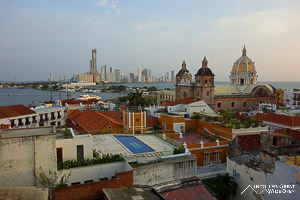Cartagena, Colombia
Return to the Walled City
September 7, 2015
Let's be Elvis and let's be David Byrne
Let's all learn how to dance
Move your feet in time
Put your hand in mine
We will waltz once again
- The Lumineers

It is always interesting to return to a place that you have visited. In this case my last visit to Cartagena was almost eight years ago at the beginning of my eight month trip through South America. Since that time, the city has changed a lot. Back in 2007, Cartagena, and all of Colombia for that matter, was not known as a tourist destination. In fact, there were still many travel warnings as the country was still emerging following the long battle between the government, the FARC, the ELN, and the drug cartels. Those days any mention of traveling to Colombia would raise some eyebrows and encouragements to be extra careful.

Now, Cartagena has been transformed into a veritable tourist destination. There are daily direct flights from New York City and Miami and cruise ships dock at the port facilities. Cartagena had always been a tourist destination for Colombians but this new increase in foreign tourist traffic has brought much development to the city. High rise condos and apartment buildings seem to be sprouting up everywhere and there are numerous upscale restaurants with all sorts of international cuisine. The streets within the old walled city are packed vendors selling all sorts of hats, cigars, and other arts and crafts. It is almost impossible not be approached by someone trying to sell you something.

During my first visit to the Cartagena I stayed in the Getsemani area that is located a few blocks from the old walled city. Back then, this area was a lower income working class neighborhood that was not so safe at night. On the main street through the neighborhood was the famous Café Habana, a great place to listen to live music with a truly authentic atmosphere. The windows, open to the streets, allowed the music to spill out into the neighborhood and only a slight breeze into the packed dance floor. In 2015, Café Habana is still popular but its renovated interior has seen the addition of closed walls and air conditioning, diminishing the ambiance of the past. The rest of the Getsemani neighborhood has also transformed into a tourist center. Numerous hostels line the main street and international restaurants including Italian and Indonesian food are ubiquitous.

Despite the addition of numerous street vendors, the old walled city has not changed too much. The narrow streets are still lined with colorful buildings, many in varying states of disrepair. Many Colombian restaurants and stores still remain and it is only the excessive presence of large groups of tourists that spoil the traditional and historical atmosphere. In this case, I was part of one of these large groups of tourists because I was visiting Cartagena for a friend’s wedding. My friend had met the bride-to-be, a Colombian, during his visit to Cartagena in 2009.

I arrived to Cartagena a few days before the wedding to spend some time with friends, see how the city had changed, and also to see some new things. Among those new things was a day trip by boat to Isla Cholon and Playa Blanca. From the port, our group was able to negotiate a private boat for the day to take us out to these destinations, about a 45 minute ride by speed boat. It was a rough ride through the open water to Isla Cholon but it was worth it. It was relatively empty mid-week but the thatched roof cabanas in the warm waist-deep water were beautiful and the cold beer and fresh seafood kept coming, making for a very relaxing time. Unfortunately Playa Blanca was not was enjoyable. From the moment our boat landed we were besieged by vendors trying to sell us all sorts of things, none of which were we actually interested in buying. It was bad enough that we only stayed to have one drink before leaving to return to Cartagena.
As enjoyable as our time was at Isla Cholon, the wedding was much more enjoyable. The ceremony took place inside the beautiful courtyard at Casa Pombo with onlookers crowded onto the various balconies and terraces around the courtyard. The ceremony was followed by dinner and then a reception with a live band and lots of dancing. There was even a “Crazy Hour” that featured dancers in costumes and choreographed activities so that there was no drop in the energy level despite the heat and humidity. The vibrant wedding festivities were capped off the following day with post-ceremony celebrations featuring more music, dancing, and drinks around the hotel pools that spilled over from the afternoon into the late evening.
Sadly, after a few entertaining days and many laughs it was time to depart. The fun-filled days, great food, and enjoyable company had been great as was the opportunity to experience a Colombian wedding. As touristy as Cartagena had become, I missed some of the city that I remembered from 2007, the rough around the edges and somewhat gritty former colonial gem that probably deserved to be discovered by all these new tourists. Fortunately, my vacation wasn’t ending just yet; my next stop was the beaches of Roatan in Honduras, a destination that promised to be even more touristy and just as hot and humid.

























































